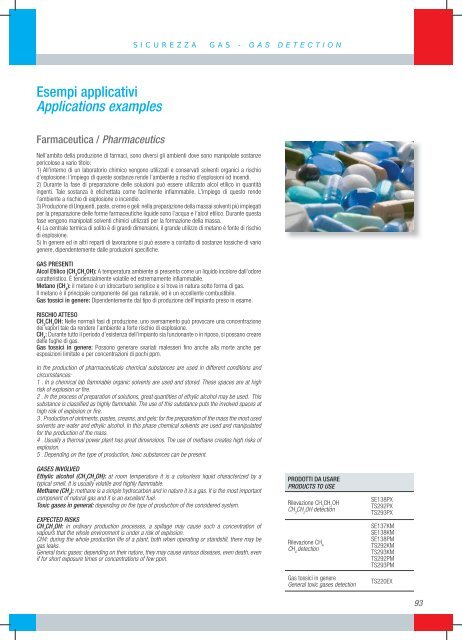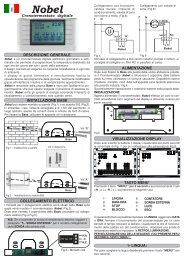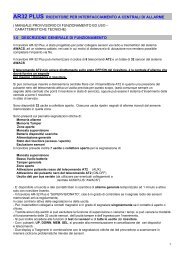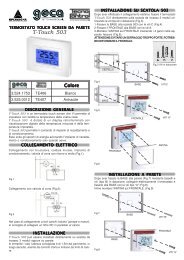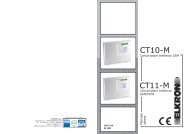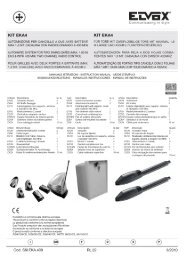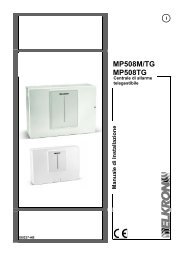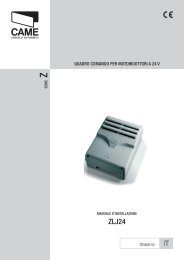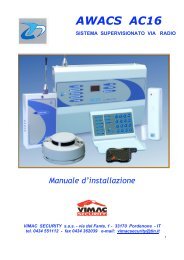Applications examples - Mgelettroforniture
Applications examples - Mgelettroforniture
Applications examples - Mgelettroforniture
Create successful ePaper yourself
Turn your PDF publications into a flip-book with our unique Google optimized e-Paper software.
SICUREZZA<br />
GAS - GAS DETECTION<br />
Esempi applicativi<br />
<strong>Applications</strong> <strong>examples</strong><br />
Farmaceutica / Pharmaceutics<br />
Nell’ambito della produzione di farmaci, sono diversi gli ambienti dove sono manipolate sostanze<br />
pericolose a vario titolo:<br />
1) All’interno di un laboratorio chimico vengono utilizzati e conservati solventi organici a rischio<br />
d’esplosione: l’impiego di queste sostanze rende l’ambiente a rischio d’esplosioni od incendi.<br />
2) Durante la fase di preparazione delle soluzioni può essere utilizzato alcol etilico in quantità<br />
ingenti. Tale sostanza è etichettata come facilmente infiammabile. L’impiego di questo rende<br />
l’ambiente a rischio di esplosione o incendio.<br />
3) Produzione di Unguenti, paste, creme e geli: nella preparazione della massai solventi più impiegati<br />
per la preparazione delle forme farmaceutiche liquide sono l’acqua e l’alcol etilico. Durante questa<br />
fase vengono manipolati solventi chimici utilizzati per la formazione della massa.<br />
4) La centrale termica di solito è di grandi dimensioni, il grande utilizzo di metano è fonte di rischio<br />
di esplosione.<br />
5) In genere ed in altri reparti di lavorazione si può essere a contatto di sostanze tossiche di vario<br />
genere, dipendentemente dalle produzioni specifiche.<br />
GAS PRESENTI<br />
Alcol Etilico (CH 3<br />
CH 2<br />
OH): A temperatura ambiente si presenta come un liquido incolore dall’odore<br />
caratteristico. È tendenzialmente volatile ed estremamente infiammabile.<br />
Metano (CH 4<br />
): il metano è un idrocarburo semplice e si trova in natura sotto forma di gas.<br />
Il metano è il principale componente del gas naturale, ed è un eccellente combustibile.<br />
Gas tossici in genere: Dipendentemente dal tipo di produzione dell’impianto preso in esame.<br />
RISCHIO ATTESO<br />
CH 3<br />
CH 2<br />
OH: Nelle normali fasi di produzione, uno sversamento può provocare una concentrazione<br />
dei vapori tale da rendere l’ambiente a forte rischio di esplosione.<br />
CH 4<br />
: Durante tutto il periodo d’esistenza dell’impianto sia funzionante o in riposo, si possano creare<br />
delle fughe di gas.<br />
Gas tossici in genere: Possono generare svariati malesseri fino anche alla morte anche per<br />
esposizioni limitate e per concentrazioni di pochi ppm.<br />
In the production of pharmaceuticals chemical substances are used in different conditions and<br />
circumstances:<br />
1 . In a chemical lab flammable organic solvents are used and stored. These spaces are at high<br />
risk of explosion or fire.<br />
2 . In the process of preparation of solutions, great quantities of ethylic alcohol may be used. This<br />
substance is classified as highly flammable. The use of this substance puts the involved spaces at<br />
high risk of explosion or fire.<br />
3 . Production of ointments, pastes, creams, and gels: for the preparation of the mass the most used<br />
solvents are water and ethylic alcohol. In this phase chemical solvents are used and manipulated<br />
for the production of the mass.<br />
4 . Usually a thermal power plant has great dimensions. The use of methane creates high risks of<br />
explosion.<br />
5 . Depending on the type of production, toxic substances can be present.<br />
GASES INVOLVED<br />
Ethylic alcohol (CH 3<br />
CH 2<br />
OH): at room temperature it is a colourless liquid characterized by a<br />
typical smell. It is usually volatile and highly flammable.<br />
Methane (CH 4<br />
): methane is a simple hydrocarbon and in nature it is a gas. It is the most important<br />
component of natural gas and it is an excellent fuel.<br />
Toxic gases in general: depending on the type of production of the considered system.<br />
EXPECTED RISKS<br />
CH 3<br />
CH 2<br />
OH: in ordinary production processes, a spillage may cause such a concentration of<br />
vapours that the whole environment is under a risk of explosion.<br />
CH4: during the whole production life of a plant, both when operating or standstill, there may be<br />
gas leaks.<br />
General toxic gases: depending on their nature, they may cause various diseases, even death, even<br />
if for short exposure times or concentrations of few ppm.<br />
PRODOTTI DA USARE<br />
PRODUCTS TO USE<br />
Rilevazione CH 3<br />
CH 2<br />
OH<br />
CH 3<br />
CH 2<br />
OH detection<br />
Rilevazione CH 4<br />
CH 4<br />
detection<br />
Gas tossici in genere<br />
General toxic gases detection<br />
SE138PX<br />
TS292PX<br />
TS293PX<br />
SE137KM<br />
SE138KM<br />
SE138PM<br />
TS292KM<br />
TS293KM<br />
TS292PM<br />
TS293PM<br />
TS220EX<br />
93


